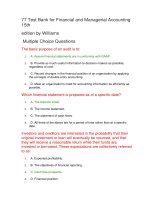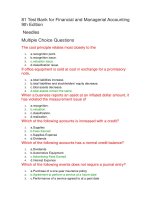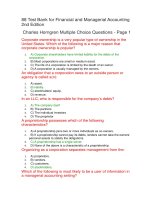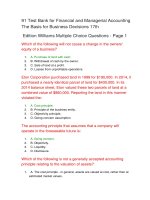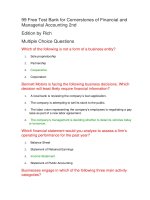Financial and managerial accounting 2nd kimel kieso willey chapter 20
Bạn đang xem bản rút gọn của tài liệu. Xem và tải ngay bản đầy đủ của tài liệu tại đây (2.79 MB, 76 trang )
20-1
20
Cost-Volume-Profit
Analysis: Additional Issues
Learning Objectives
20-2
1
Apply basic CVP concepts.
2
Explain the term sales mix and its effects on breakeven sales.
3
Determine sales mix when a company has limited
resources.
4
Indicate how operating leverage affects profitability.
LEARNING
OBJECTIVE
1
Apply basic CVP concepts.
CVP analysis is:
20-3
The study of the effects of changes in costs and volume
on a company’s profit.
Important to profit planning.
Critical in management decisions such as:
►
determining product mix,
►
maximizing use of production facilities,
►
setting selling prices.
LO 1
Basic Concepts
20-4
Management often wants the information reported in a
special format income statement.
CVP income statement is for internal use only:
►
Costs and expenses classified as fixed or variable.
►
Reports contribution margin as a total amount and
on a per unit basis.
LO 1
Basic Concepts
Illustration 20-1
Basic CVP income
statement
20-5
LO 1
Basic Concepts
20-6
Illustration 20-2
Detailed CVP
income statement
LO 1
Basic Computations
BREAK-EVEN ANALYSIS
Illustration: Vargo Video’s CVP income statement (Ill. 20-2)
shows that total contribution margin is $320,000, and the
company’s contribution margin per unit is $200. Contribution
margin can also be expressed in the form of the contribution
margin ratio which in the case of Vargo is 40% ($200 ÷ $500).
Illustration 20-3
Illustration 20-4
20-7
LO 1
Basic Computations
TARGET NET INCOME
Once a company achieves break-even sales, a sales goal can be
set that will result in a target net income
Illustration: Assuming Vargo’s target net income is $250,000,
required sales in units and dollars to achieve this are:
(Fixed Costs + Target
Net Income)
($200,000 + $250,000)
Unit Contribution
÷
Margin
Required Sales
=
in Units
÷
=
$200
2,250 units
Illustration 20-5
Target net income in units
20-8
LO 1
Basic Computations
TARGET NET INCOME
Once a company achieves break-even sales, a sales goal can be
set that will result in a target net income
Illustration: The contribution margin ratio is used to compute
required sales in dollars.
(Fixed Costs + Target
Net Income)
÷
Contribution
Margin Ratio
($200,000 + $250,000)
÷
.40
Required Sales
=
in Dollars
=
$1,125,000
Illustration 20-6
Target net income in dollars
20-9
LO 1
Basic Computations
MARGIN OF SAFETY
tells
us how far sales can drop before the company will
operate at a loss.
can
be expressed in dollars or as a ratio.
Illustration: Assume Vargo’s sales are $800,000:
Actual (Expected )
Sales
-
Break-Even
Sales
$800,000
-
$500,000
Margin of Safety
=
in Dollars
=
$300,000
Illustration 20-7
Margin of safety in dollars
20-10
LO 1
Basic Computations
MARGIN OF SAFETY
tells
us how far sales can drop before the company will
operate at a loss.
can
be expressed in dollars or as a ratio.
Illustration: Vargo’s sales could drop by $300,000, or 37.5%,
before the company would operate at a loss.
Margin of Safety in
Dollars
-
$300,000
-
Actual (Expected)
Margin of Safety
=
Sales
in Ratio
$800,000
=
37.5%
Illustration 20-8
Margin of safety ratio
20-11
LO 1
CVP and Changes in the Business
Environment
Illustration: Original camcorder sales and cost data for Vargo
Video:
Illustration 20-9
20-12
LO 1
CVP and Changes in the Business
Environment
CASE I: A competitor is offering a 10% discount on the selling
price of its camcorders. Management must decide whether to offer
a similar discount.
Question: What effect will a 10% discount on selling price ($500
x 10% = $50) have on the breakeven point?
Fixed Costs
÷
Unit Contribution
Margin
=
$200,000
÷
$150
=
Break-Even
Sales
1,334 units
Illustration 20-10
Computation of break-even
sales in units
20-13
LO 1
CVP and Changes in the Business
Environment
CASE II: Management invests in new robotic equipment that will
lower the amount of direct labor required to make camcorders.
Estimates are that total fixed costs will increase 30% and that
variable cost per unit will decrease 30%.
Question: What effect will the new equipment have on the sales
volume required to break even?
Fixed Costs
$260,000
Illustration 20-11
Computation of break-even
sales in units
20-14
Unit Contribution
÷
Margin
=
÷
=
($500 - $210)
Break-Even
Sales
897 units (rounded)
LO 1
CVP and Changes in the Business
Environment
CASE III: Vargo’s principal supplier of raw materials has just
announced a price increase. The higher cost is expected to
increase the variable cost of camcorders by $25 per unit.
Management decides to hold the line on the selling price of the
camcorders. It plans a cost-cutting program that will save $17,500
in fixed costs per month. Vargo is currently realizing monthly net
income of $80,000 on sales of 1,400 camcorders.
Question: What increase in units sold will be needed to maintain
the same level of net income?
20-15
LO 1
CVP and Changes in the Business
Environment
CASE III:
Variable cost per unit increases to $325 ($300 + $25).
Fixed costs are reduced to $182,500 ($200,000 - $17,500).
Contribution margin per unit becomes $175 ($500 - $325).
(Fixed Cost + Target
Net Income)
-
Unit Contribution
Margin
=
($182,500 + $80,000)
-
$175
=
Required Sales
in Units
1,500
Illustration 20-12
Computation of required sales
20-16
LO 1
Basic Concepts
Question
Croc Catchers calculates its contribution margin to be less
than zero. Which statement is true?
a. Its fixed costs are less than the variable cost per unit.
b. Its profits are greater than its total costs.
c. The company should sell more units.
d. Its selling price is less than its variable costs.
20-17
LO 1
Management Insight
Amazon.com
Don’t Just Look—Buy Something
When analyzing an Internet business such as Amazon. com, analysts closely
watch the so-called “conversion rate.” This rate is calculated by dividing the
number of people who actually take action at an Internet site (buy something) by
the total number of people who visit the site. Average conversion rates are from
3% to 5%. A rate below 2% is poor, while a rate above 10% is great. Conversion
rates have an obvious effect on the breakeven point. Suppose you spend
$10,000 on your site, which then attracts 5,000 visitors. If you get a 2%
conversion rate (100 purchases), your site costs $100 per purchase ($10,000 ÷
100). A 4% conversion rate lowers your cost to $50 per transaction, and an 8%
conversion rate gets you down to $25. Studies show that conversion rates
increase if the site has an easy-to-use interface, fast-performing screens, a
convenient ordering process, and advertising that is both clever and clear.
Sources: J. William Gurley, “The One Internet Metric That Really Counts” Fortune (March
6, 2000), p. 392; and Milind Mody, “Chief Mentor: How Startups Can Win Customers
Online,” Wall Street Journal Online, (May 11, 2011).
20-18
LO 1
DO IT! 1
CVP Analysis
Krisanne Company reports the following operating results for the month of June
2017.
To increase net income, management is considering reducing the selling price
by 10%, with no changes to unit variable costs or fixed costs. Management is
confident that this change will increase unit sales by 25%. Using the contribution
margin technique, compute the break-even point in units and dollars and margin
of safety in dollars (a) assuming no changes to sales price or costs, and (b)
assuming changes to sales price and volume as described above. (c) Comment
on your findings.
20-19
LO 1
DO IT! 1
CVP Analysis
Krisanne Company reports the following operating results for the month of June
2017.
20-20
LO 1
DO IT! 1
CVP Analysis
Krisanne Company reports the following operating results for the month of June
2017.
20-21
(b) Assuming changes to sales price and volume:
Break-even point in units = 5,556 units (rounded) ($100,000 ÷ $18b)
Break-even point in sales dollars = $300,000 ($100,000 ÷ ($18 ÷ $54c))
Margin of safety in dollars = $37,500 ($337,500d 2 $300,000)
b$60 - (.10 x $60) - $36 = $18
c$60 - (.10 x $60)
d5,000 + (.25 x 5,000) = 6,250 units, 6,250 units x $54 = $337,500
LO 1
DO IT! 1
CVP Analysis
Krisanne Company reports the following operating results for the month of June
2017.
(c)
20-22
The increase in the break-even point and the decrease
in the margin of safety indicate that management should not implement the
proposed change. The increase in sales volume will result in contribution
margin of $112,500 (6,250 x $18), which is $7,500 less than the current
amount.
LO 1
LEARNING
OBJECTIVE
2
Explain the term sales mix and its
effects on break-even sales.
Break-Even Sales in Units
Sales
mix is the relative percentage in which a
company sells its products.
If
a company’s unit sales are 80% printers and 20%
computers, its sales mix is 80% to 20%.
Sales
mix is important because different products
often have very different contribution margins.
20-23
LO 2
Break-Even Sales in Units
Companies can compute break-even sales for a mix of two or
more products by determining the weighted-average unit
contribution margin of all the products.
Illustration: Vargo Video sells not only camcorders but TV sets
as well. Vargo sells its two products in the following amounts:
1,500 camcorders and 500 TVs. The sales mix, expressed as a
function of total units sold, is as follows.
Illustration 20-13
Sales mix as a percentage
of units sold
20-24
LO 2
Break-Even Sales in Units
Additional information related to Vargo Video.
Illustration 20-13
Illustration 20-14
Per unit data—sales mix
20-25
LO 2



